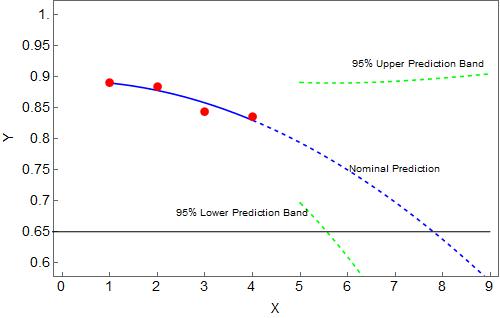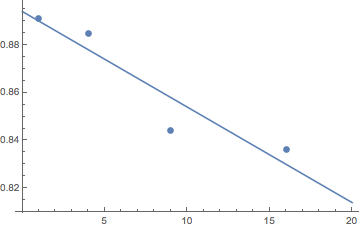I have found NonlinearModelFit to be extremely useful in my work. Here I have fit 4 points to a function and am being asked to explain how the 95% SinglePredictionBands associated with the plot below were derived/computed. Can someone show how these bands can be computed from “first principles” ? In other words, I’d need to use Mathematica to independently produce the functions labeled lowerband and upperband. My code is below. Many thanks.
x = {1, 2, 3, 4};
y = {0.891, 0.885, 0.844, 0.836};
data1 = Transpose[{x, y}];
plot1 = ListPlot[data1, Frame -> True,
FrameTicks -> {Range[0, 5, 1], Range[0.8, 0.9, .05], None, None},
FrameLabel -> {"X", "Y"}, PlotRange -> {{0, 5}, {0.8, 0.9}},
PlotStyle -> Red, ImageSize -> 500,
LabelStyle -> Directive[Black, FontSize -> 14]];
Remove[a, b];
model1 = NonlinearModelFit[data1, a + b t^2, {a, b}, t] ;
Normal[model1];
params = model1["BestFitParameters"];
{a = params[[1, 2]], b = params[[2, 2]]};
predictionbands = model1["SinglePredictionBands"];
lower[t_] := predictionbands[[1]];
upper[t_] := predictionbands[[2]];
plot1a = Plot[model1[t], {t, 1, 4}, Frame -> True, PlotStyle -> Blue,
PlotRange -> {{0, 4}, All}];
plot1b = Plot[model1[t], {t, 4, 9}, Frame -> True,
PlotStyle -> {Blue, Dashed}, PlotRange -> All];
plot2a = Plot[lower[t], {t, 5, 9}, Frame -> True,
FrameTicks -> {Range[0, 9, 1], Range[0, 0.9, .1], None, None},
PlotRange -> All, PlotStyle -> {Green, Dashed}];
plot2b = Plot[upper[t], {t, 5, 9}, Frame -> True,
FrameTicks -> {Range[0, 9, 1], Range[0.5, 1, .1], None, None},
PlotRange -> {0.5, 1}, PlotStyle -> {Green, Dashed}];
text1 = Text["95% Upper Prediction Band", {7.5, .92}];
text2 = Text["95% Lower Prediction Band", {3.8, .68}];
text3 = Text["Nominal Prediction", {7, .75}];
plot3 = Show[plot1b, plot1a, plot2a, plot2b, plot1,
AxesOrigin -> {0, 0}, PlotRange -> {.6, 1},
FrameTicks -> {Range[0, 9, 1], Range[.6, 1, .05], None, None},
FrameLabel -> {"X", "Y"},
Epilog -> {Line[{{-1, .65}, {9, .65}}], text1, text2, text3},
ImageSize -> 500, ImageSize -> 500,
LabelStyle -> Directive[Black, FontSize -> 14]]

Here are the SinglePredictionBands that I need to independently produce.
lowerband = model1["SinglePredictionBands"][[1]]
0.894058 - 0.00400775 t^2 - 4.30265 Sqrt[0.000237726 - 0.0000163949 t^2 + 1.09299*10^-6 t^4]
upperband = model1["SinglePredictionBands"][[2]]
0.894058 - 0.00400775 t^2 + 4.30265 Sqrt[0.000237726 - 0.0000163949 t^2 + 1.09299*10^-6 t^4]


